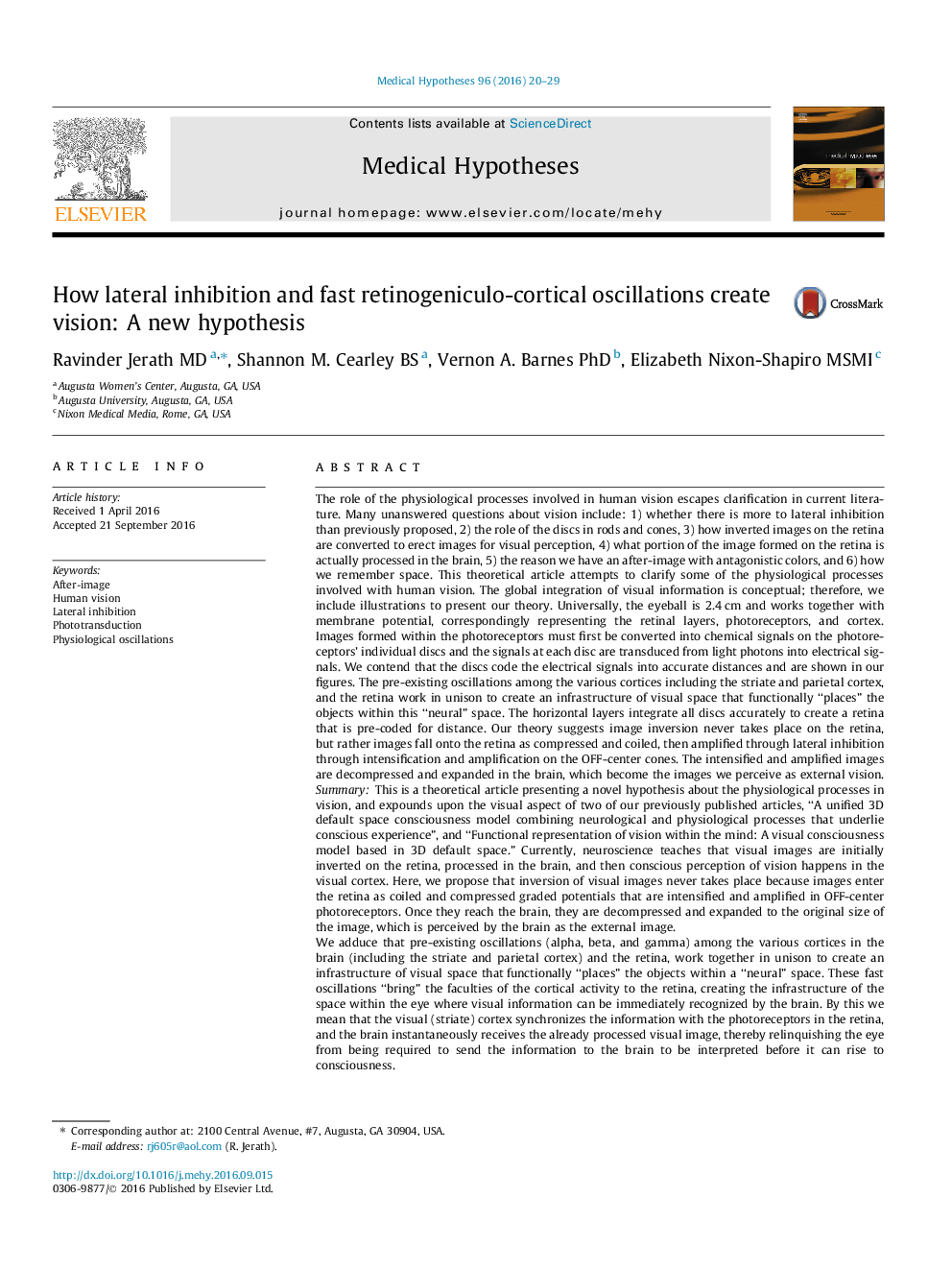| کد مقاله | کد نشریه | سال انتشار | مقاله انگلیسی | نسخه تمام متن |
|---|---|---|---|---|
| 5548640 | 1556549 | 2016 | 10 صفحه PDF | دانلود رایگان |
The role of the physiological processes involved in human vision escapes clarification in current literature. Many unanswered questions about vision include: 1) whether there is more to lateral inhibition than previously proposed, 2) the role of the discs in rods and cones, 3) how inverted images on the retina are converted to erect images for visual perception, 4) what portion of the image formed on the retina is actually processed in the brain, 5) the reason we have an after-image with antagonistic colors, and 6) how we remember space. This theoretical article attempts to clarify some of the physiological processes involved with human vision. The global integration of visual information is conceptual; therefore, we include illustrations to present our theory. Universally, the eyeball is 2.4 cm and works together with membrane potential, correspondingly representing the retinal layers, photoreceptors, and cortex. Images formed within the photoreceptors must first be converted into chemical signals on the photoreceptors' individual discs and the signals at each disc are transduced from light photons into electrical signals. We contend that the discs code the electrical signals into accurate distances and are shown in our figures. The pre-existing oscillations among the various cortices including the striate and parietal cortex, and the retina work in unison to create an infrastructure of visual space that functionally “places” the objects within this “neural” space. The horizontal layers integrate all discs accurately to create a retina that is pre-coded for distance. Our theory suggests image inversion never takes place on the retina, but rather images fall onto the retina as compressed and coiled, then amplified through lateral inhibition through intensification and amplification on the OFF-center cones. The intensified and amplified images are decompressed and expanded in the brain, which become the images we perceive as external vision.SummaryThis is a theoretical article presenting a novel hypothesis about the physiological processes in vision, and expounds upon the visual aspect of two of our previously published articles, “A unified 3D default space consciousness model combining neurological and physiological processes that underlie conscious experience”, and “Functional representation of vision within the mind: A visual consciousness model based in 3D default space.” Currently, neuroscience teaches that visual images are initially inverted on the retina, processed in the brain, and then conscious perception of vision happens in the visual cortex. Here, we propose that inversion of visual images never takes place because images enter the retina as coiled and compressed graded potentials that are intensified and amplified in OFF-center photoreceptors. Once they reach the brain, they are decompressed and expanded to the original size of the image, which is perceived by the brain as the external image.We adduce that pre-existing oscillations (alpha, beta, and gamma) among the various cortices in the brain (including the striate and parietal cortex) and the retina, work together in unison to create an infrastructure of visual space that functionally “places” the objects within a “neural” space. These fast oscillations “bring” the faculties of the cortical activity to the retina, creating the infrastructure of the space within the eye where visual information can be immediately recognized by the brain. By this we mean that the visual (striate) cortex synchronizes the information with the photoreceptors in the retina, and the brain instantaneously receives the already processed visual image, thereby relinquishing the eye from being required to send the information to the brain to be interpreted before it can rise to consciousness.The visual system is a heavily studied area of neuroscience yet very little is known about how vision occurs. We believe that our novel hypothesis provides new insights into how vision becomes part of consciousness, helps to reconcile various previously proposed models, and further elucidates current questions in vision based on our unified 3D default space model. Illustrations are provided to aid in explaining our theory.
Journal: Medical Hypotheses - Volume 96, November 2016, Pages 20-29
